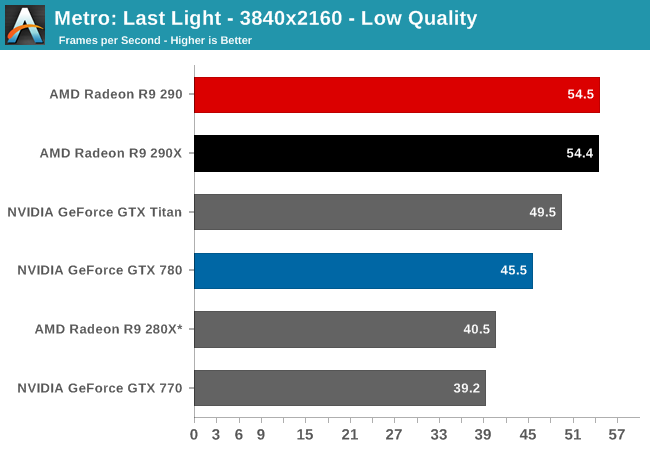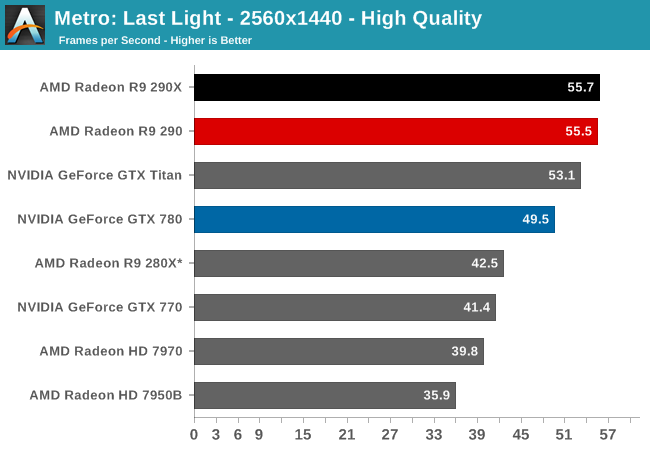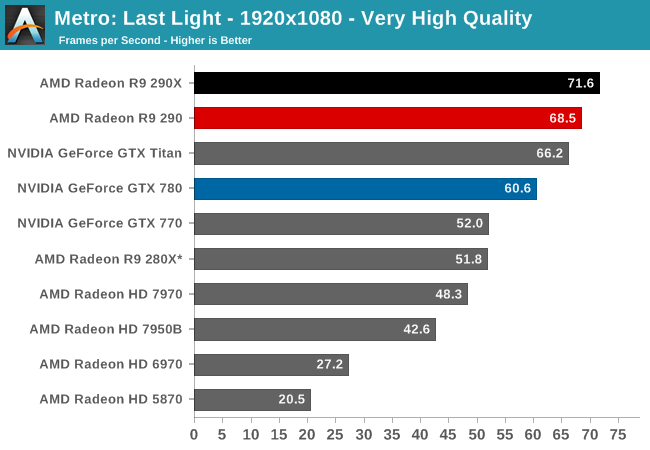The AMD Radeon R9 290 Review
by Ryan Smith on November 5, 2013 12:01 AM EST- Posted in
- GPUs
- AMD
- Radeon
- Hawaii
- Radeon 200
Metro: Last Light
As always, kicking off our look at performance is 4A Games’ latest entry in their Metro series of subterranean shooters, Metro: Last Light. The original Metro: 2033 was a graphically punishing game for its time and Metro: Last Light is in its own right too. On the other hand it scales well with resolution and quality settings, so it’s still playable on lower end hardware.



For the bulk of our analysis we’re going to be focusing on our 2560x1440 results, as monitors at this resolution will be what we expect the 290 to be primarily used with. A single 290 may have the horsepower to drive 4K in at least some situations, but given the current costs of 4K monitors that’s going to be a much different usage scenario. The significant quality tradeoff for making 4K playable on a single card means that it makes far more sense to double up on GPUs, given the fact that even a pair of 290Xs would still be a fraction of the cost of a 4K, 60Hz monitor.
With that said, there are a couple of things that should be immediately obvious when looking at the performance of the 290.
- It’s incredibly fast for the price.
- Its performance is at times extremely close to the 290X
To get right to the point, because of AMD’s fan speed modification the 290 doesn’t throttle in any of our games, not even Metro or Crysis 3. The 290X in comparison sees significant throttling in both of those games, and as a result once fully warmed up the 290X is operating at clockspeeds well below its 1000MHz boost clock, or even the 290’s 947MHz boost clock. As a result rather than having a 5% clockspeed deficit as the official specs for these cards would indicate, the 290 for all intents and purposes clocks higher than the 290X. Which means that its clockspeed advantage is now offsetting the loss of shader/texturing performance due to the CU reduction, while providing a clockspeed greater than the 290X for the equally configured front-end and back-end. In practice this means that 290 has over 100% of 290X’s ROP/geometry performance, 100% of the memory bandwidth, and at least 91% of the shading performance.
So in games where we’re not significantly shader bound, and Metro at 2560 appears to be one such case, the 290 can trade blows with the 290X despite its inherent disadvantage. Now as we’ll see this is not going to be the case in every game, as not every game GPU bound in the same manner and not every game throttles on the 290X by the same degree, but it sets up a very interesting performance scenario. By pushing the 290 this hard, and by throwing any noise considerations out the window, AMD has created a card that can not only threaten the GTX 780, but can threaten the 290X too. As we’ll see by the end of our benchmarks, the 290 is only going to trail the 290X by an average of 3% at 2560x1440.
Anyhow, looking at Metro it’s a very strong start for the 290. At 55.5fps it’s essentially tied with the 290X and 12% ahead of the GTX 780. Or to make a comparison against the cards it’s actually priced closer to, the 290 is 34% faster than the GTX 770 and 31% faster than the 280X. AMD’s performance advantage will come crashing down once we revisit the power and noise aspects of the card, but looking at raw performance it’s going to look very good for the 290.










295 Comments
View All Comments
geok1ng - Tuesday, November 5, 2013 - link
blowers are not inherently bad, take a look at HIS ICE Q reviews for the 7950 and you will see that as long as the TDP is compatible with the cooler, blowers can beat open air solutions in temps and noise.jnad32 - Tuesday, November 5, 2013 - link
Blowers are also nice because they put most of the hot air outside the case, instead of dumping into the case to cool faster.misfit410 - Tuesday, November 5, 2013 - link
If the custom cooling solutions come quickly, that's a steal.konzelmann - Tuesday, November 5, 2013 - link
Great card for the money. If you can't live with the noise then obviously it's not the card for you, but I think the majority of serious gamers who would be buying such a card probably are going to be able to live with the noise by using headphones which they probably would be using anyway for the sake of voice communication while they're playing, etc. Or you can spend the money you saved and get a good aftermarket cooler that will be quiet and you'll still have great performance for a good value.fingerbob69 - Tuesday, November 5, 2013 - link
Quite simply, Anad is WRONG on the noise level. 57dba is a considerably higher measurement than recorded by Hexus and Guru3d (my prefered as they put noise levels into context) while [H], Techp. and Bit-tech all say its much the same as the 290x and in no way a deal breaker.And it seems noise doesn't scale:
290x @ 40% fan = 53dba
290 @ 47% fan = 57dba
290x @ 55% fan = 58dba
Only Anad has come out so empthatically against the 290 ...but with a dba reading 17.5% higher than anyone else ...is that a surprise?
To be recording this card at over 10dba more than any other review site tells us that Anad should revisit this test.
A5 - Tuesday, November 5, 2013 - link
You should read the byline of the review and learn how to spell "Anand" correctly.Also, it's probably a difference in measurement procedure. You can't compare dB numbers across sites.
awg1031 - Tuesday, November 5, 2013 - link
guru3d praises this card with their review..but their review doesn't covered as much as anandkudos to anand..
but since anandtech keep whining about the noise without proper solution..kudos to tomshardware for having review and a simple review of how 3rd party solution could solve the noise issue..
http://www.tomshardware.com/reviews/radeon-r9-290-...
Yuriman - Tuesday, November 5, 2013 - link
I already have a waterblock that fits this card. Anyone with a watercooling loop can basically throw out *all* of the negative aspects of the 290.JaredC01 - Tuesday, November 5, 2013 - link
I agree completely. You can pick up this card and a full-card waterblock for less than the total cost of a 290X, and you still get nearly 100% of the performance of the 290X out of the box. Add in the overclock and silence of watercooling, and there's literally no reason for anyone with a water loop to buy a 290X.DMCalloway - Tuesday, November 5, 2013 - link
Running a single loop with this card linked in is going to add heat that needs to be dissipated and those fans on the radiator aren't usually silent. Silent water cooling is still kind of an oxymoron. Granted it will be quieter than reference cards, however cards with after market cooling solutions should offer a fairly quiet choice.